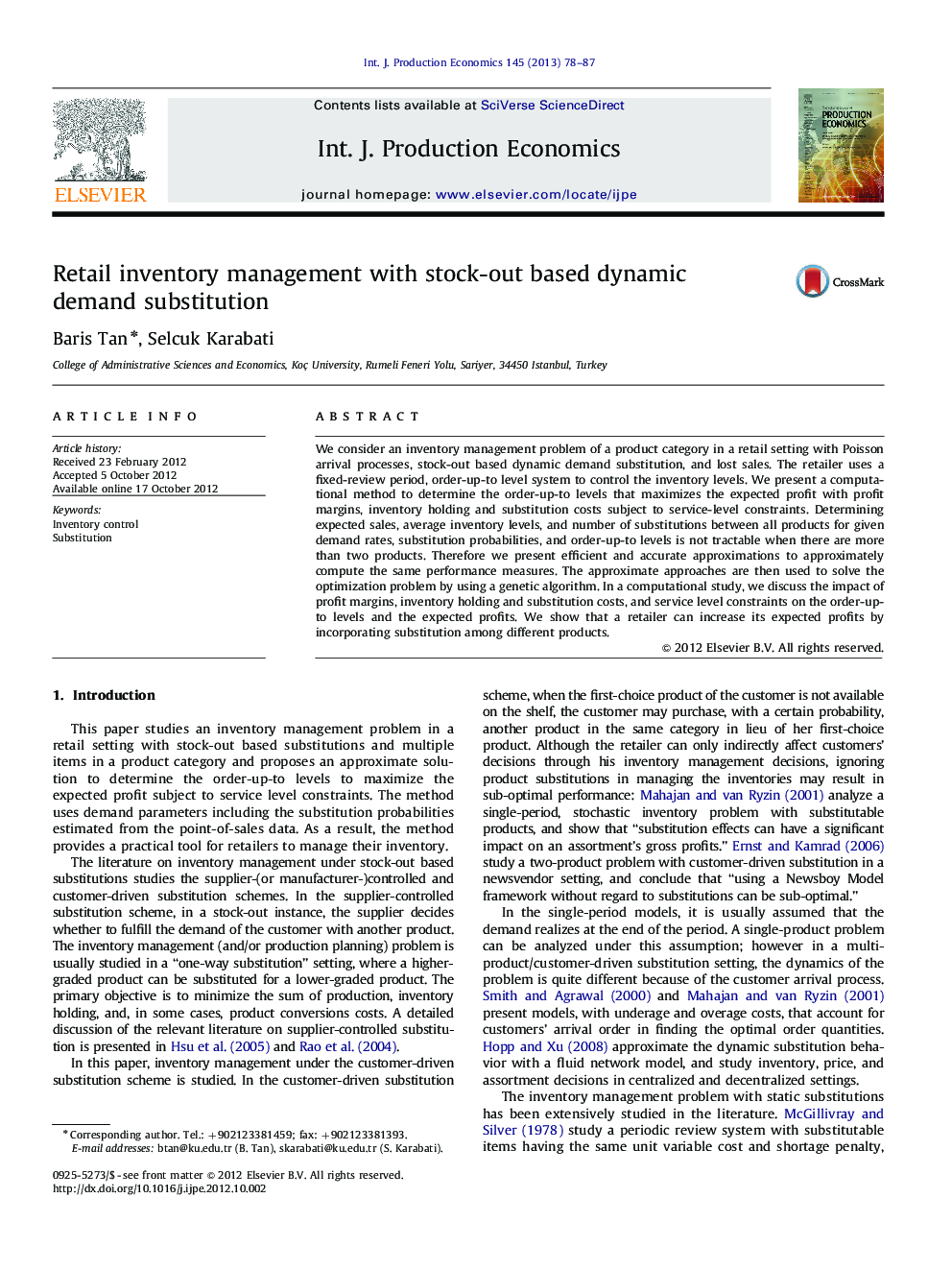| کد مقاله | کد نشریه | سال انتشار | مقاله انگلیسی | نسخه تمام متن |
|---|---|---|---|---|
| 5080497 | 1477571 | 2013 | 10 صفحه PDF | دانلود رایگان |
عنوان انگلیسی مقاله ISI
Retail inventory management with stock-out based dynamic demand substitution
ترجمه فارسی عنوان
مدیریت موجودی خرده فروشی با جایگزینی تقاضای پویای مبتنی بر سهام
دانلود مقاله + سفارش ترجمه
دانلود مقاله ISI انگلیسی
رایگان برای ایرانیان
کلمات کلیدی
کنترل انبار، جایگزینی،
ترجمه چکیده
ما یک مشکل مدیریت موجودی یک دسته محصول را در مجموعه خرده فروشی با پردازش ورودی پوآسون، جایگزینی تقاضای پویای مبتنی بر سهام، و فروش از دست دادیم. خرده فروش با استفاده از یک دوره بررسی ثابت، سیستم مرتبه به سطح برای کنترل سطوح موجودی. ما یک روش محاسباتی برای تعیین سطوح سفارش به سطوح که حداکثر سود مورد انتظار را با حاشیه سود، هزینه نگهداری موجودی و جایگزینی مطابق با محدودیت های سطح خدمات ارائه می کنیم. تعیین میزان فروش مورد انتظار، میانگین میزان موجودی و تعداد جایگزینی بین تمام محصولات برای نرخ های تقاضا داده شده، احتمال جایگزینی و ترتیب به سطوح، زمانی که بیش از دو محصول وجود دارد، قابل قبول نیست. بنابراین ما تقریبی کارآمد و دقیق را برای تقریبا محاسبه ی یک معیارهای عملکرد مشابه ارائه می دهیم. سپس روشهای تقریبی برای حل مشکل بهینه سازی با استفاده از یک الگوریتم ژنتیکی مورد استفاده قرار می گیرند. در یک مطالعه محاسباتی، ما در مورد تاثیر حاشیه سود، هزینه نگهداری موجودی و جایگزینی، و محدودیت های سطح خدمات در مورد نظم به سطوح و سود مورد انتظار بحث می کنیم. ما نشان می دهیم که یک خرده فروش می تواند سود خود را با ترکیب جایگزینی در میان محصولات مختلف افزایش دهد.
موضوعات مرتبط
مهندسی و علوم پایه
سایر رشته های مهندسی
مهندسی صنعتی و تولید
چکیده انگلیسی
We consider an inventory management problem of a product category in a retail setting with Poisson arrival processes, stock-out based dynamic demand substitution, and lost sales. The retailer uses a fixed-review period, order-up-to level system to control the inventory levels. We present a computational method to determine the order-up-to levels that maximizes the expected profit with profit margins, inventory holding and substitution costs subject to service-level constraints. Determining expected sales, average inventory levels, and number of substitutions between all products for given demand rates, substitution probabilities, and order-up-to levels is not tractable when there are more than two products. Therefore we present efficient and accurate approximations to approximately compute the same performance measures. The approximate approaches are then used to solve the optimization problem by using a genetic algorithm. In a computational study, we discuss the impact of profit margins, inventory holding and substitution costs, and service level constraints on the order-up-to levels and the expected profits. We show that a retailer can increase its expected profits by incorporating substitution among different products.
ناشر
Database: Elsevier - ScienceDirect (ساینس دایرکت)
Journal: International Journal of Production Economics - Volume 145, Issue 1, September 2013, Pages 78-87
Journal: International Journal of Production Economics - Volume 145, Issue 1, September 2013, Pages 78-87
نویسندگان
Baris Tan, Selcuk Karabati,
